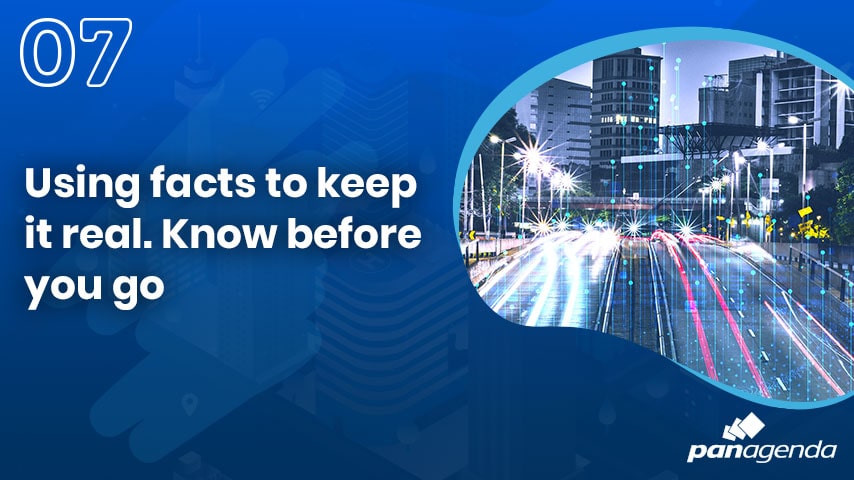Way #7 of 7 New Ways to Master Your Domino Application Migration Challenges
Migrating your business process applications off the Domino platform is not the straightforward, cookie-cutter process that some might suggest. There are many complexities involved, and pitfalls await those IT groups that move forward too quickly without first understanding all the facts from an in-depth investigation of their Domino environment.
In this blog, aptly entitled, “KNOW before you go”, we introduce a set of best practices that we have learned over the years from assisting customers through detailed assessments of their Domino application deployments. Prior to any risky, high-profile migration planning project it is imperative that the team leading the effort does their due diligence to understand all the facts. Application migration and modernization projects are hugely expensive and can quickly run off he rails by making assumptions and underestimating complexity. So how can you stack the deck in your favor for an accurate Domino application migration project estimate? Read on and you will see.
STEP 1: Shrink the Number
When Domino application assessments begin there is usually a huge number of databases flagged for analysis. Sometimes that number is daunting and scary to consider as part of a complete redevelopment effort. However, that first number is NEVER the reality. The first phase of any assessment will greatly reduce the number of applications by following this three-pronged approach. More details in our previous blog on ‘Navigating your Domino projects with confidence’.
Archive and Decommission Inactive Apps
By analyzing usage and activity data the project team can quickly identify applications that are no longer needed. From years of experience we have found that this number is usually quite large. Most organizations that have run Domino for 10+ years will have 40% or more of their applications in this inactive state. These applications should be archived off and removed from consideration. More details in our previous blog on ‘Keeping your cost estimates efficient from the start’.
Group Simple Applications for Easy Migration
The second analysis pass for Domino applications is to catalog the simplest apps that can be quickly transitioned to another platform by migrating the data. There are many target platforms available where these types of applications which can be migrated with minimal effort involved. The other option is to simply leave these applications in place on Domino, accessible through a Web Browser interface. You can even add a little beautification for the UI to spruce up these applications which were built from old, well-known templates such as Document Libraries, Threaded Discussions, or Mail-in Databases. More details in our previous blog on ‘Most successful assessment projects start with a consolidation’.
Group Remaining Custom Applications with Similar Designs
After identifying the inactive and simple apps, the remaining applications will move into this next phase of the assessment. Most organization will have loads of applications that are very similar in design. They were originally built from a series of templates that were morphed over time, but their actual design DNA such as navigation UI, forms, views, security roles, data storage, and custom code segments, plus their business process functions are still very close. More details in our previous blog on ‘Get the big picture by comparing your application code’.
During a comparative design pass these applications should NOT be considered unique, complex apps which would each require a custom redevelopment effort to migrate them to a new platform. Instead these should be counted as grouped application types to reduce the overall number of apps further. Only one of each design type will require scoping and estimation for redevelopment in the next step.
STEP 2: Use Experts and Facts to Scope Custom Applications for Migration
Now that you have greatly reduced the actual number of applications to consider for a redevelopment and migration effort, it is time to dig in and understand these remaining custom apps completely. Get all the facts and learn the true nature of these applications and exactly what business processes they support.
More details in our previous blog on ‘About the roadblocks in your source code’.
This is best served by combining two separate efforts. Firstly, interview the application owners and power users. More details in our previous blog on ‘Finding application stakeholders’.

They will provide all the insights on the complexity of the data, security requirements and process workflows included within the applications. And secondly, perform a detailed forensic analysis of the application designs and datastores by using an automated solution like iDNA Applications. Only by gathering the facts from these two methods will your team acquire the full visibility and knowledge to target the best matching platform for migration and accurately scope the level of effort involved to perform the redevelopment and data transfer.
**Note: when scoping the redevelopment and migration effort be sure to leverage consulting groups with experience on both sides of the fence (Notes/Domino and the Target Platforms).
RECOMMENDATION: Keep Complex Applications on Domino until Ready
Custom built, business process applications running on Domino are full of complicated workflows, tailored forms and views, intricate security roles, and multi-faceted reporting functions. They should be scoped individually for redevelopment and migration effort along with the assistance of the department owner and power users. Until the budget and resources are available to modernize these complex applications and incorporate the updated business processes, workflow, security, and reporting needs, they should remain on Domino.
CONCLUSION: Get the FACTS First, then Scope Your Migration Effort
Can you handle the truth? To make accurate, well-informed migration decisions for your Domino application environment it is important to get the facts, all the facts. They will provide you with a complete understanding of what is involved. These migration projects are highly visible from upper management (more details here: ‘Ways to provide accurate progress reports’), especially for critical business process applications that drive revenue for the company. Make sure you analyze these from all angles, so you understand the truth.
If you are interested in finding out more about our iDNA Applications solution and how it can help you get the facts about your Domino application environment, please visit our overview page online, or sign-up for a trial at https://www-test.panagenda.com/products/idna/.
Many companies around the world have been committed to HCL Notes/Domino* for years. They know the many benefits that come from that relationship. Additionally, Notes/Domino lies at the center of their processes and how they work. Despite all this, IT decisions makers around the world are starting to envision a future where Notes/Domino may play a reduced role or no role at all.
*formerly IBM Notes/Domino

